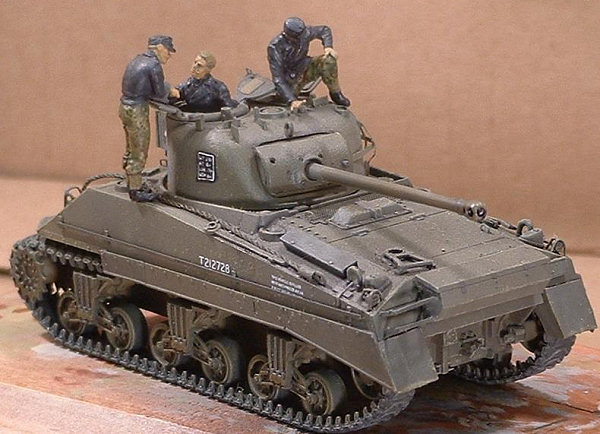| The Vehicle The
Sherman VC was one of the Sherman family of tanks
produced in the United States and provided to allies
during the Second World War. A modification of the
Sherman V (M4A4), it used a Chrysler A57 multibank engine
(five automobile engines surrounding a common drive
shaft) in a hull lengthened by 5 inches. The Sherman VC
carried a OQF 17 pound gun and was used by British,
Commonwealth and Polish forces during the later half of
the Second World War. I chose to represent Allakeefek, a
Sherman VC of the 4th County of London
Yeomanry (the Sharpshooters), which was captured during
the fighting around Villers Bocage on June 13, 1944.
The Kit
This is the recently released
Dragon Firefly VC (kit #7303). It is a nicely moulded kit
in plastic, with soft plastic glueable T-54E1 tracks. The
turret has the shell ejection port moulded in place.
- Allakeefek was well
photographed following the disaster of Villers
Bocage. It was captured at Point 213, just
outside of the town, where A Squadron was trapped
after Michael Wittman's Tiger I entered the town.
There is no obvious battle damage to the tank, so
it may have broken down and been abandoned in the
road.
- 4th County of
London Yeomanry had served in North Africa and
carried some of their traditions and habits to
North West Europe. For example, the name
"Allakeefek" is an Arab slang term
meaning "Can't be bothered". Another
hold-over from their desert days is the sand
shields and the baggage rail welded to the sides
of the tank.

Modifications:
- As mentioned above,
the Dragon Firefly has a shell ejection port
moulded in place. Allakeefek's turret did not
have a port. I therefore began by blanking off
the port and filling it with putty.

- The Dragon kit does
not offer sand shields, so I adapted a set which
comes with the Italieri/ESCI M4A1. These were far
too thick so I spent a couple of evenings sanding
them down to a more correct thickness. The end
pieces were scratched out of sheet styrene.

- Since the tank I
was modeling included a stowage rack on the
glacis, I scratched suitable representation out
of stock styrene. The cable comes with the US
versions of the Dragon Sherman and I borrowed one
from a kit not yet started.

- The webbing on the
side of the turret was created using thin strips
of masking tape.

- Since the Regiment
had not been in France for very long, there
wasn't a lot of stowage. You can see in the photo
above that one box has been welded to the rear
deck. It is not clear exactly what the box
originally held, but it looks like an ammo
container of some kind. It seems to be too small
for a 3.7 inch antiaircraft shell box, which is
what I originally thought it was. I represented
it with a generic box that seemed the right size.
- Dragon provides a
nice sheet of photo etch for things like handles
and headlight brush guards, so I used them.
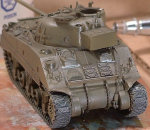
- Details were added
to the interior of the hatches (periscope,
handles and padding).

- The decals are from
Bison Decals set No. 72006 "Firefly Vc &
British M4 Variants" and are very nice, thin
and in register. The only problem I found was
that the name "Allakeefek" which goes
on the radio box at the rear of the turret is a
tad too big. On the plus side the warning about
the antifreeze on each side is actually legible
if you look closely.
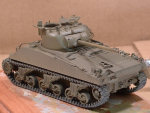
- I wanted to portray
the tanks after it had been captured and as it is
shown in the photos available. As a result, I
needed figures to represent the SS troopers who
are doing the "tourist thing" -
checking out the Sherman VC (which would be new
to them). I used Preiser figures, painted in a
mix of black panzer uniforms and camo, which
seems to be common in the photos. I also added
two infantry figures (a machinegun crew) moving
up toward the fighting, also by Preiser.
- The base is home
made, from an old plaque with acrylic paste for
built up areas, Portland cement for the road, and
railway flocking for the grass. I also used dust
from the Portland cement to weather the tank -
this works really effectively, almost like
pigments. You sprinkle it on and remove what you
don't want with a brush.
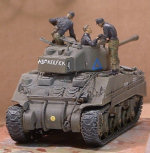
Paint
The kit was painted over-all in a
Tamiya XF-62 Olive Drab with Tamiya Medium Blue used to
reduce the browness and lightened with Tamiya Buff XF-57.
I added several thin washes of Humbrol Green 117 because
the Tamiya still seemed a bit too brown. The Olive mix
was changed over the course of several coats of various
shades to add depth and variety to the base coat. A wash
of heavily thinned black enamel was used to highlight
detail. The model was clear-coated in gloss prior to the
decals being. Model Master Clear Flat, mixed with a lot
of thinner and a bit of Tamiya Buff was used to seal the
decals. The track was painted in Humbrol 67 Matt Panzer
Dark Gray, with a lighter dry brushing of Humbrol 64 Matt
Light Gray.
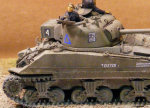
Source Documents
Taylor, Daniel, Villers Bocage
Through the Lens, Battle of Britain International
Limited, London, U.K.: 1999.
Hayward, Mark, Sherman Firefly,
Barbarossa Books, Tiptree, Essex, U.K.: 2001
Fortin, Ludovic, British Tanks
in Normandy, Histoire & Collections, Paris,
France: 2005
|
